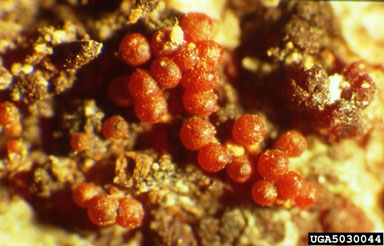DACF Home → Bureaus & Programs → Maine Forest Service →Forest Health & Monitoring → Forest Pest Index → Sirococcus Shoot Blight of Red Pine
Sirococcus Shoot Blight of Red Pine
Hosts:
Red Pine (Pinus resinosa); Several other conifer species are also affected.
General information:
Infection of red pines by Sirococcus shoot blight has become increasingly common throughout Maine and other New England states over the past decade. Many red pine plantations were established in Maine and northern New England after harvesting spruce and fir stands damaged by the spruce budworm during the 1970’s and 1980’s. These plantations are now showing a high susceptibility to injury and mortality from Sirococcus shoot blight. The disease is also found in native red pine stands.
Infection potential is largely driven by favorable weather conditions of cool, wet springs and summers; conditions which have been common in most of the Northeast for the past decade. The favorable weather conditions and the concentration of suitable host material (plantations) can result in a rapid build-up of the pathogen and infection potential. Growth reduction results from chronic infection and in some cases tree mortality can occur after several years high disease incidence and severity. Spread within an infected plantation can develop rapidly.

Symptoms and Signs:
The disease infects current-year needles soon after they emerge from the buds during the spring and early summer. The fungus then has the ability to grow from the needles into the current-season shoots, and can kill the shoot tips. Symptoms of infection include the browning of recently in-fected needles and later, the curling of infected shoot tips. Often, as tips die, lateral buds below the infection take over apical dominance and subsequently die. As this happens repeatedly, the outer portions of branches take on a bushy appearance referred to as ‘lion’s tailing’.
Spores of the fungus are produced in pycnidia and appear as small black dots on the needles (often under the needle sheath at the base of needle fascicles) and on shoots of infected trees. Branches die as terminal buds and shoots can no longer support new growth. As the infections progress over a period of several years, usually from the lower branches to the upper branches, tree mortality can eventually occur. Additional stress-related pest issues may also appear in infected stands.
Management:
For ornamentals, hand pruning infected tips and applications of protectant fungicides are options for management. In forest stands and plantations, management of the disease will be considerably more challenging. Frequent and regular monitoring of stands will be critical. Early detection will allow flexibility in devising a management strategy. Thinning stands to maximize air circulation and surface-drying of needles can help to reduce infections. Thinning is suggested, even in stands with trees that would not ordinarily be considered large enough for a thinning treatment, but should be limited to stands with an average live crown ratio greater than 40%. Heavily infected trees and dead trees will lose quality rapidly, and will need to be salvaged quickly to recover whatever value they have.
MAINE DEPARTMENT OF AGRICULTURE, CONSERVATION AND FORESTRY
Maine Forest Service - Forest Health and Monitoring Division
March 2018